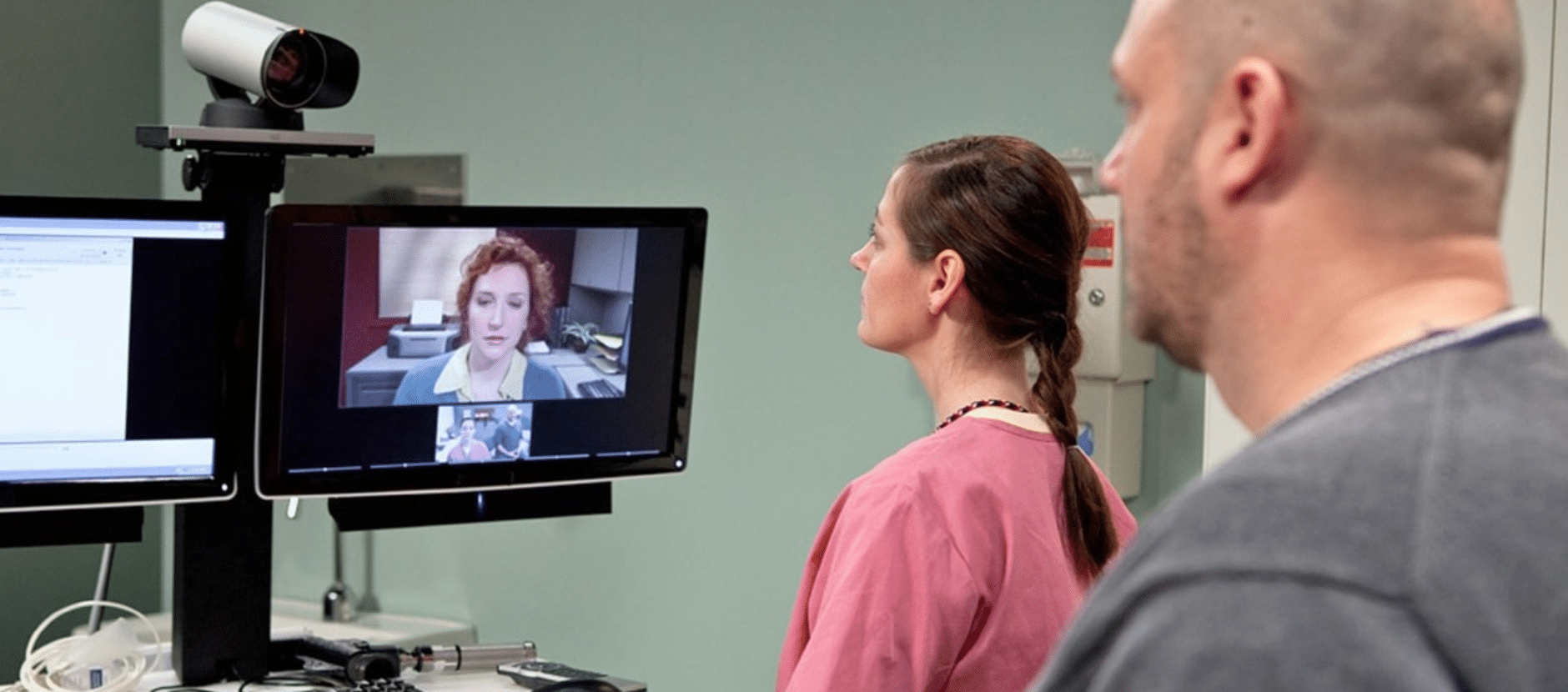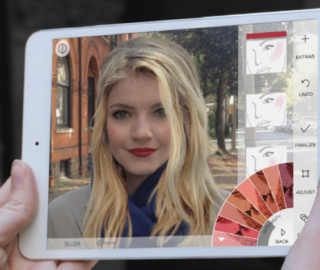
Telehealth (or Telemedicine) is a growing sector of the healthcare industry which has steadily gained traction and formed a profitable sector, according to Transparency Market Research. The market research firm projects that total US revenue will hit $19.5 billion in 2025 up from $6 billion in 2016.
The implementation of telehealth practices and technology is showing increased adoption among healthcare providers and institutions. Results from a 2017 survey of 436 medical professionals conducted by telemedicine software company REACH Health shows that 51 percent ranked telemedicine as a “top” or “high’ priority in their practice.
In an effort to increase clinical and administrative capacity through telehealth, researchers are developing AI-driven technology for healthcare professionals and consumers.
This article will set out to determine the answers to the following questions:
- What types of AI applications are emerging to improve telehealth capabilities in the healthcare industry?
- How is the healthcare market implementing these AI applications?
According to the Health Resources and Services Administration (HRSA) of the US Department of Health and Human Services, telehealth is defined as the “use of electronic information and telecommunications technologies to support and promote long-distance clinical health care, patient and professional health-related education, public health and health administration.”
Examples of technologies used in delivering telehealth include video conferencing and the Internet of Things (IoT).
The Federal Communications Commission (FCC) defines telehealth as a broader form of telemedicine, encompassing “remote healthcare services beyond the doctor-patient relationship” such as interactions with nurses, pharmacists and social services personnel.
Our research suggests that the majority of AI use cases and emerging applications for telehealth appear to fall into two main categories:
- Virtual Consultations: When companies develop platforms for video consultations between patients and medical professionals, while providers use machine learning to help analyze clinical data in a patient’s electronic health or medical record (EHR/EMR) to provide patient care recommendations.
- Diagnostic Support: When companies develop machine learning algorithms for chatbots to recommend a diagnosis based on symptoms and patient health data.
Below, we present examples from each category, as well as the current progress (funds raised, pilot applications, etc) of each example.
Virtual Consultations
Lemonaid Health
Founded in 2013 with headquarters in San Francisco, Calif., Lemonaid Health claims that it uses machine learning to provide same-day video consultations with medical professionals and to coordinate delivery of prescription medications.
In May 2017, the company announced its goal to optimize its current algorithms with the capabilities of machine learning. Its current algorithms are reportedly trained on data from clinical guidelines used to recommend prescriptions for doctors to consider when evaluating patients.
To date, the company reports that it has processed over 48,000 doctor visits in 14 states. It seems that patient data from these doctor visits may be used to train the algorithms but we are not able to confirm this.
When the Lemonaid Health app is downloaded to a patient’s smartphone, the process begins with the completion of an online health questionnaire. Information collected from the questionnaire includes medical history, current medicines, allergies and current symptoms.
This information is used to help match the user with a medical professional. A video consultation is usually available within two minutes with an assigned physician or nurse practitioner (NP).
If the doctor or NP determines that a prescription is needed, the patient has the option of choosing free delivery or picking the medicine up at their local pharmacy. Prescriptions are sent by medical professional electronically to the pharmacy. The cost of a complete online doctor’s visit is $25, which goes directly to Lemonaid Health. From our research, it was not clear how or if the doctor or health facility is compensated for the visits by Lemonade or other resources.
The 20-second video below provides a quick snapshot of the Lemonaid Health app and examples of features:
Lemonaid Health’s medical team includes physicians affiliated with institutions such as San Francisco General Hospital, University of California, Davis and the Uniformed Services University in Bethesda, MD.
Co-founder and CEO, Paul Johnson, earned his undergraduate Computer Science and Business Management degree from the University of Worcester.
No case studies are currently available on the company’s website or through online searches. From our research, it was also unclear if Lemonaid has any marquis clients. However, they seem to have ties to local health facilities and pharmaceuticals as they refer patients to lab facility services including STD, cholesterol and blood testing; as well as branded medications including Viagra; Cialis and Yasmine.
The company has also partnered with digital prescription management and delivery service, Phil. Inc. during Phil’s 2017 expansion, according to a press release. There has been no further news, from our research, about how the companies assisted each other and if the partnership created results for each.
As of May 2017, Lemonaid Health has raised $11 million in Series A funding. Google estimates over 50,000 installations of the app.
InfiniteMD
Founded in 2015 and based in Boston, InfiniteMD claims it is developing AI algorithms to recommend treatment options for cancer patients.
The startup provides patients with second-opinion video consultations from medical specialists in the United States.
In June 2018, the company entered a trial phase in June 2018 which would add AI features to its previous human-run business of matching patients with health providers or clinical trials.
When using InfiniteMD and its new AI features, a patient begins by submitting a video consultation request on the InfiniteMD website along with their medical records. Internally, the goal is for the AI platform to recommend treatment options specific to the user’s needs and provide information on treatment availability (i.e. the patient’s country or the United States). The AI platform can also determine if the user meets the patient profile criteria for any clinical trials, according to the company.
According to the company, data used to generate these recommendations and train algorithms includes previous recommendations from medical specialists who’ve partnered with InfiniteMD, other data from medical cases managed by the startup, the latest information on clinical trials and current professional guidelines for oncologists.
Before a patient gets their recommendations, the AI-driven suggestions are sent to a human InfiniteMD admin who reviews this data as well as submitted documents, like medical records. Once the application’s suggestions are verified, the human admin will use the overall data to match the patient with a specialist who most closely meets their needs.
Medical specialists can also review the AI recommendations to help make further treatment recommendations. Finally, the video consultation is scheduled and takes place using a desktop or mobile device with a camera. The health provider then sends a summary of the consultation to the patient following the session.
It is unclear if the AI platform would be available to patients or only used internally by the InfiniteMD team and its medical specialists.
In the 1-minute video below, InfiniteMD CEO and Co-Founder Liz Kwo, MD, MPH, MBA discusses how the platform is reaching patients through video consultations, predominantly in China. We could not find a traditional demo or product shot from our research:
The company claims that “28 percent of cases result in a change or correction in diagnosis
72 percent of cases result in a revised treatment plan.” No case studies are currently available on the InfiniteMD website.
Examples of clients include the CLL Society, a nonprofit addressing the needs of Chronic Lymphocytic Leukemia patients and related blood cancer communities, partners with InfiniteMD to administer its Expert Access™ Program. According to CLL, this partnership allows the society to further connect and facilitate strategic relationships with a national pool of large hospital systems, as well as oncology experts and specialists referred by InfiniteMD.
InfiniteMD medical specialists are affiliated with hospitals such as Massachusetts General Hospital, Boston Children’s Hospital and Memorial Sloan Kettering Cancer Center.
A search for current staff with AI or machine learning expertise on the company’s LinkedIn did not yield results. However, it is important to note that CEO Liz Kwo received her medical training from Harvard and co-founders Babak Movassaghi, PhD and Christopher Lee, PhD received their business and science training from Harvard and Massachusetts Institute of Technology respectively. As of January 2018, the startup has raised $1.5 million in Series A funding.
Although the company has gained much in funding and has implemented machine learning into its program, it’s AI application is still very nascent. It is unclear from our research if it has been successful, or implemented into any patient experiences, to date.
Diagnostic Support
HealthTap
Founded in 2010 with headquarters in Palo Alto, California, HealthTap claims it uses AI and machine learning to help users identify their potential ailment and its probable causes.
The company has been a competitor in the video consultation market providing 24/7 access to doctor consultations via video, text, and voice interactions. In December 2016, the startup announced the launch of its assistant called Dr. A.I.
Developed over a six-year period, the algorithms are reportedly trained on thousands of patient questions and doctor responses from HealthTaps’ network of over 105,000 physicians across 141 medical specialties. Case studies are not currently available on HealthTap’s website.
Upon downloading the app on a mobile device, the user will first provide some health details to create a personal health record. Examples of requested data include age, prior medical conditions, gender and current medications. Next, the chatbot will ask a series of personalized questions based on their health record to gauge the user symptoms. User responses are compared with doctor responses to similar cases in the database to generate recommendations for care.
The 3-minute video below demonstrates how users can schedule a health appointment using HealthTap:
In the 5-minute interview below, HealthTap CEO Ron Gutman discusses how Dr. A.I. works and can also be accessed through Amazon’s Alexa device:
According to HealthTap’s LinkedIn page, data scientists with machine learning expertise include Kai Yuan Kuan, a former Apple data manager who received his Master’s in Statistics from Stanford University. Data Scientist Jeevan Gyawali has served as a data scientist at GE and previously received a Bachelor’s in Mathematics from Cornell University. No other robust AI background could be found in the company’s leadership.
We could find no case studies on HealthTap, however, this may be due to its AI’s nascency as Dr. A.I. was not launched until 2016.
Google currently estimates over 1 million downloads of the HealthTap app and the company claims its database of answered questions has grown to 6.2 billion. As of January 2017, the company has raised a total of $88.3 million in Series C funding. While the company does not list clients or case studies, its Investors include Khosla Ventures and Asset Management Ventures.
Ada Health
Launched in 2016, and based in Berlin, Germany Ada Health claims its telemedicine app uses AI and machine learning to provide personalized diagnosis support.
Following a reported a six-year R&D period, the development team rolled out the chatbot which uses a series of questions to suggest what a user, or patient, ailment may be based on symptom information that the patient gives the bot.
The app’s algorithms are trained on a large database of thousands of symptoms and medical conditions. After downloading the app, the user completes an initial survey assessment which helps the app to develop a patient profile. Responses to the app’s questions are compared to a larger pool of similar cases to suggest possible symptoms.
The 40-second demo below demonstrates how the app helps users identify possible symptoms by prompting the user with questions and suggestions via a chat interface:
As of July 2018, Ada Health reports hosting over 4 million users worldwide and “5 million symptom assessments completed with.” Case studies are not currently available on the company’s website. October 2017 marks $69.3 million in Series A funding raised by the company. Investors include Access Technology Ventures and the June Fund.
While we could not find full case studies from the company, its Community page features video testimonials from health providers at two Berlin, Germany-based hospitals: Vivantes Hospital and the Charité.
It is unclear if there are any active health-provider clients in the US which are implementing the chatbot into their patient processes. However, the “Ada – Your Health Guide” mobile app has over a 4.75-star rating in the Google Play store with over 88 thousand reviews.
Examples of data scientists on Ada Health’s team include Senior AI Scientist, Vera Hartenstein, a PhD in Mathematics and Theoretical Physics who trained at Ludwig-Maximilians-Universität München. She also previously specialized in Data mining at the Munich Re Group,
Another Senior Data Scientist, Lynn Marx, a PhD in Particle Physics from the University of Manchester, served as a Postdoctoral Research Scientist at the University of Washington, where she focused on building cluster algorithms for statistical data analysis and optimizing pattern recognition programs.
Concluding Thoughts
Our research identified two main categories for the application of AI in telehealth. Chatbots and video-conferencing platforms offer interesting opportunities for expanding the reach and accessibility of healthcare services.
Chatbots offer simple and quick access to information to many users at one time while access to one-on-one video conferencing may be more limited based upon the available providers in a company’s network. In contrast, more complex cases such as cancer are not well suited for chatbots and video consultations with specialists would more appropriate.
Virtual Consultation platforms such as InfiniteMD demonstrate an example of the growing relationship between telemedicine and the medical tourism industry. In short, medical tourism is the act of traveling to another country for medical care.
The Centers for Disease Control and Prevention cautions that there are inherent risks that should be considered such as increased antibiotic resistance outside of the US and potential misunderstandings in care due to language barriers. Despite these risks and varying revenue figures, the global medical tourism has been estimated as a growing billion dollar industry.
There are also certain barriers to implementation of telehealth technology ranging from general preference to legal implications. For example, Lemonaid Health’s is limited to certain states which is partly due to state licensing limitations. In this case, a physician in one state would not be licensed to treat a patient in another state.
Conflicting information exists on the cost implications and potential savings of telemedicine. Lemonaid Health claims its $25 cost is less expensive than the average health insurance copayment. However, some studies suggest that there are high costs and lack of reimbursement for telemedicine services.
While some aspects of telehealth are not new, it is important to remember that AI implementation in this area is still very nascent. While many of the applications listed were affiliated with investors or clients, many of them were just branching into AI telehealth strategies. Similarly, none of them had case studies or results which could measure the impact of AI or their basic services yet.
As the field continues to evolve, the role of AI may also shift to meet new demands. Further research and case studies will be needed to determine its sustainability and value long term.
Header image credit: Federal Times







